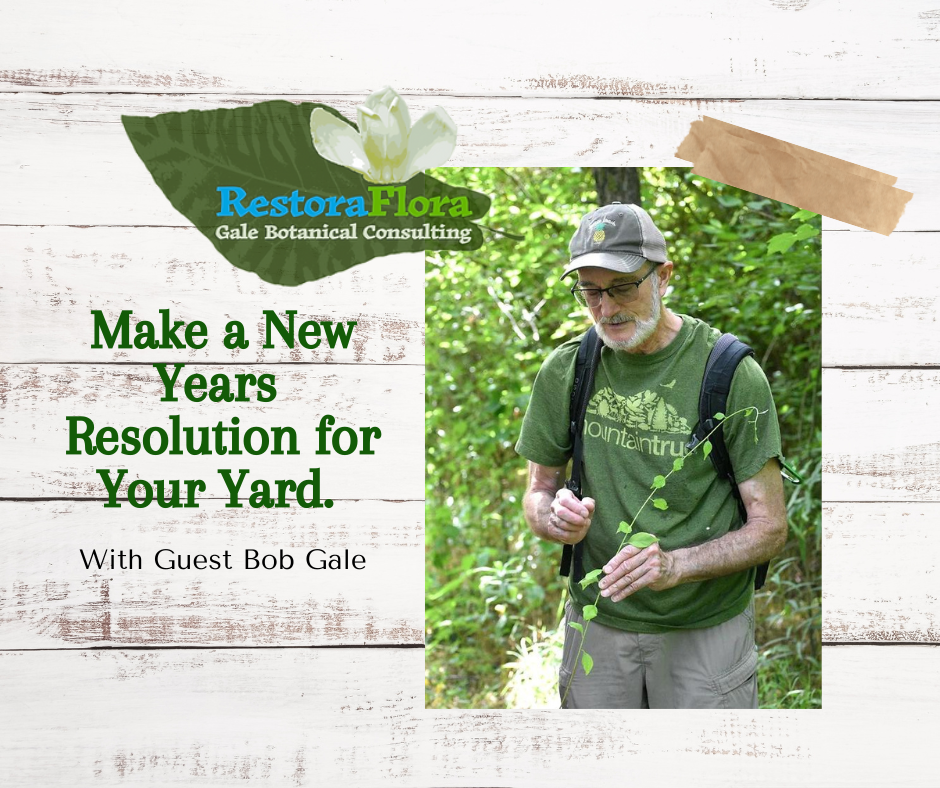Make a New Year’s Resolution for Your Yard!

By Guest Contributor: Bob Gale of RestoraFlora Gale Botanical Consulting
Many of us make personal resolutions at the start of each year — we’ll exercise more, be better listeners, read more books, and so on. (Whether we keep those resolutions or not is another matter, but we won’t focus on that here!) Well, 2024 gives us, once again, a new opportunity to make these personal promises.
The question is, have you considered making a New Years resolution for your yard in 2024? Or, do you just say something like, “I can’t wait until spring comes, so I can get outside again and plant my vegetables and some flowers.” If you’re like most people, you say this every year and maybe you pretty much accomplish this work. But, also like many, you might let life get in the way and get things in the ground later than you intended, or maybe never even got around to planting some things as you had hoped. Early in the year, you had a more grandiose, and somewhat nebulous, plan floating around in your mind, but which then dissolved, as spring turned into summer and then fall. This pattern often gets repeated each year.
But it could be much different. By making a definitive resolution — actually writing it out and following it — you can accomplish some wonderful things.
Here’s how:
Ask yourself some questions. What is the condition of my property? Is it a natural forest that is fine, but needs a little management? Are there non-native invasive plants that need controlling? Is it in a haphazard condition, needing a “design?” If so, what would you really like your yard to become; what would your dream yard look like? Who else might benefit from this vision, and how?
If your site does need moderate to major enhancement, focus in a little more. Is your goal an aesthetically pleasing floral display? Do you want a garden to provide a bountiful harvest of vegetables with some colorful flowers along its borders? Perhaps you want to attract more birds to your yard, or pollinating insects and butterflies. Maybe you want all of these.
 Well, you can have them! But to succeed, you must resolve to make this project a priority. And then create a plan to get you there. This plan should set step-by-step goals and a schedule to accomplish them. And, if you have kids, involve them in your project! They may not be overjoyed by such “work,” but it will come back to them years later as a fun family memory and will “plant the seeds” of gardening in their minds, which will likely then become their hobby as adults.
Well, you can have them! But to succeed, you must resolve to make this project a priority. And then create a plan to get you there. This plan should set step-by-step goals and a schedule to accomplish them. And, if you have kids, involve them in your project! They may not be overjoyed by such “work,” but it will come back to them years later as a fun family memory and will “plant the seeds” of gardening in their minds, which will likely then become their hobby as adults.Determine where any shady, partly shady, or full sun areas occur in your yard. Too much sun? Maybe you need plant some trees. Too many trees and shady areas? Maybe some strategic limb pruning would add sun, or maybe one or two overcrowded or unhealthy trees could be removed.
Topography
What’s the topography of your site? Is it mostly level or are there gentle/moderate slopes? Some light grading may be needed to achieve your vision. Are there steep slopes? These might need some terracing or a retaining wall.
Soils

Your personal space can take on any design you come up with and host many different native plants to fit within them; the sky (and your budget, of course) is the limit. But, in order to make your project happen, set a schedule for completing its parts one by one throughout the months of 2024. Find times to fit each step into your normal schedule. Even if you can only devote an hour per week (preferably the same day and time), try to stick to your weekly schedule. By doing so, you will not only keep your New Years resolution for your yard, you’ll continually appreciate the beauty of your creation and gain a tremendous feeling of accomplishment. In addition, the wild creatures will appreciate living in a safe and healthy community and they will reward you generously with their presence!!
For more information on non-native invasive plants, NNIP removal, and replacement with native insect and wildlife attractive plants, visit “Services” at www.restoraflora.com.
